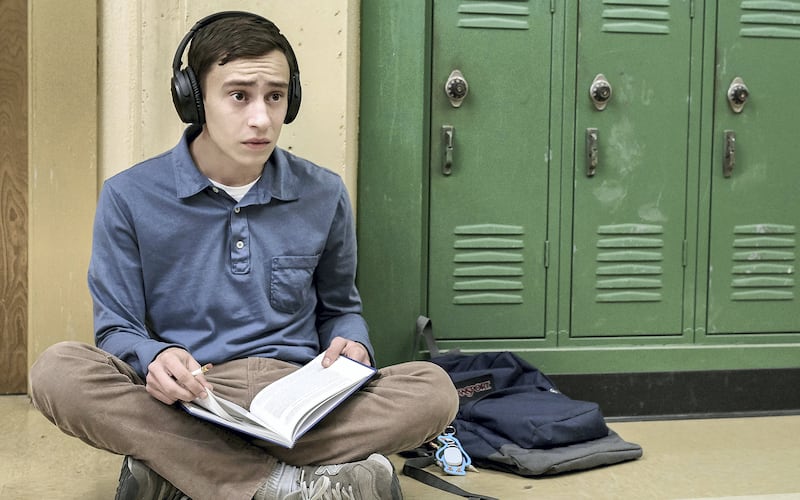Television and the media in general have an inglorious history of portraying people who live with disability as pitiable, sinister even; a curiosity or a burden, unable to participate in daily life.
Thankfully, such stereotypes are fading in the face of scripts that portray a more modern sensibility. One such show is Atypical, a coming-of-age sitcom that follows Sam – a sweet and smart 18-year-old on the autistic spectrum – as he searches for love and independence.
In this Netflix global original, which is available from Friday, the English-born Canadian actor Keir Gilchrist spins viewers in a fresh direction as he learns all about dating and other rituals of adulthood, on a funny but emotional journey of self-discovery.
Meanwhile, the rest of his family grapple with waves of change in their own lives.
While Gilchrist doesn't share Sam's autism, his character laments: "I'm a weirdo. That's what everyone says. Sometimes I don't know what people mean when they say things.
"Girls don't really notice me at all, and I'm not great at picking up signals. Sometimes I wish I was normal."
At its core, the series embraces the huge question teens face – what does normal really mean?
"The theme of Atypical is that no one's normal, But Sam's probably the most normal one of all of them," says show creator Robia Rashid. "One of the cool things about Atypical is that this is a guy who's just like all of us."
Jennifer Jason Leigh, who plays his fretful mother Elsa, sums up her TV son's dilemma: "Sam's coming into his independence... He wants a girlfriend.... Keir is really perfect. He never gets cute with it.… You feel like he's very much in Sam's shoes."
Over eight episodes, Sam discovers the awful truth – that nobody is normal, with the help of his loving family, which also includes his father Doug, played by Michael Rapaport, and his protective younger sister, Casey (Brigette Lundy-Paine) who goes so far as to write his online dating profile.
"Sam's honesty is the most relatable part of him," says Gilchrist, 24.
"Most people will relate to the way he puts into the words the difficulties [of] dating. The way he describes some situations is basically how everyone feels, but most people don't actually put it into words."
To get the medical science and the family story right, Rashid says she consulted with a California State University professor who works with the Center for Autism Research and Treatment in Los Angeles.
"Atypical goes deep into the magical world of the mind of someone with autism," says Lundy-Paine. "So much of the show is told from inside Sam's head. So it's this treasure trove of experiences."
This is in marked contrast to the early decades of television, where all too often TV producers and writers took the lazy shortcuts of relying upon disability as a character trait, plot device or for atmosphere – using the disabled as the "hook" into the story – and viewing them through their impairment.
One of the most reliable indicators of the representation of characters with disabilities on television today is the Where We Are On TV report, prepared annually by GLAAD, a non-governmental media-monitoring organisation.
In its 2016-2017 edition, it notes that while 12.6 per cent of United States non-institutionalised citizens report living with an apparent disability, "primetime programming continues to fall incredibly short in reflecting the reality of this demographic".
"This year, the percentage and number of series regulars with disabilities has risen to 1.7 per cent [15 characters] from last year's 0.9 per cent [eight characters]," the report states.
"This is the highest percentage of inclusion since GLAAD began gathering disability statistics in the 2010-11 season."
"As noteworthy as these numbers are, in comparison with previous tracked seasons, they lack far
behind the actual representation of people with disabilities found in our communities nationwide," says Jennifer Laszlo Mizrahi, president of RespectAbility, a US non-profit organisation dedicated to empowerment and self-advocacy of individuals with disabilities.
"The only way to create authenticity within entertainment television is if characters with obvious and hidden disabilities are included within every script and storyline, just as they are found within the diversity of our everyday lived experience," she says.
"All too often, these characters are featured when there is a focus on disability within the script; when in reality, characters with disabilities should be included in the vast majority of roles that are non-descript and have nothing to do with a particular disability. Only then, will these percentages improve."
In what can only be viewed as rare but genuine progress, more actors who actually live with disability are being allowed to portray characters like themselves — where their disability is merely a part of who they are, not their sum total, as in real life.
________________
Read more:
Every child deserves proper educational support
Fidget spinners: how the latest toy craze also benefits children with special needs
Music strikes the right note with children with autism
Parents must take charge and set a healthy example for their children
________________
Spearheading this breakthrough almost a decade ago was R J Mitte, the disabled advocate and charismatic star of Breaking Bad (2008-2013), who was born with cerebral palsy, just like his character Walter White Jr.
Along with Atypical, another series that broke the one-dimensional mould is Speechless – the hit family sitcom which debuted last year with Minnie Driver as the fiercely protective mother of J J, her non-verbal son with cerebral palsy – portrayed in a breakout performance by Micah Fowler, who lives with the disorder off-camera as well.
"I'm sick of seeing disabled people, people with special needs – whatever the verbiage is you choose to use – depicted as people who can't wait to die and want to get away from it," says Driver.
"It's awful. These are robust, amazing lives that need to be celebrated. They need to have a laugh, God knows."
Seth Gordon, director and producer of Atypical, says: "There's something beautiful about making a show that's about a character with special needs, but isn't a show about the special needs – it's just a kid in the family."
Atypical is available for streaming on Netflix from Friday





